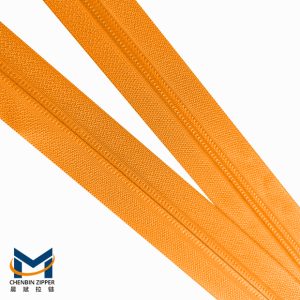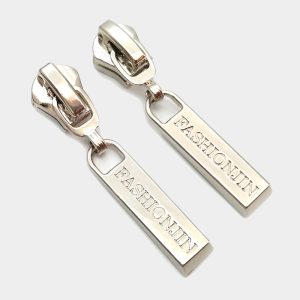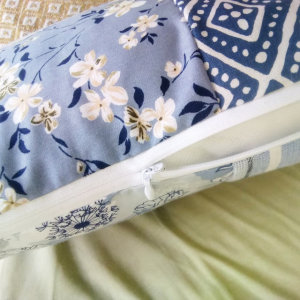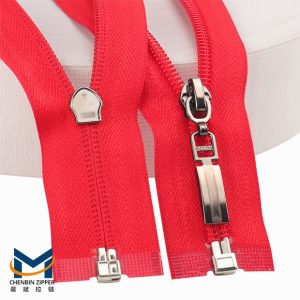Overview of Coil Zippers
Introduction to Coil Zippers
Coil zippers play an essential role in the realm of fastenings, providing a dependable and smooth mechanism for numerous applications. Their distinctive design and adaptability make them a favored option across various sectors, including fashion and outdoor equipment. By comprehending their mechanics and functionality, one can truly value the innovation behind this straightforward yet crucial device.
Historical Background
The history of coil zippers dates back to the early 1900s, when people were beginning to explore innovative way to fasten. Over the decades, the durable and efficient design appeared. After continuous improvements in materials and manufacturing processes, the disk zipper was initially adopted by the apparel industry and has penetrated many other sectors since then.
Key Characteristics
Referring to its key characteristics, the Coil Zipper is known for its flexibility and durability. The interlocking coils ensure a smooth gliding action, reducing resistance during use. These zippers are lightweight, making them suitable for both heavy-duty and delicate applications. Moreover, they can easily bend and conform to various shapes without compromising their functionality, showcasing the brilliance of their design.
How Coil Zippers Work
Construction and Design
The construction of a Coil Zipper involves a series of interwoven coils, typically made from polyester or nylon, sewn onto a fabric tape. This design allows for a continuous and flexible fastening mechanism. The precision in the placement and alignment of these coils is crucial, ensuring a smooth and reliable operation across various stress conditions.
Materials Used
The main materials employed in Coil Zipper manufacturing are polyester and nylon, valued for their durability and flexibility. These substances undergo rigorous quality control measures to ensure they can endure repeated use and strain. The selection of fabric for the tape is also crucial, with choices spanning from cotton to synthetic blends, each offering unique advantages based on the specific application needs.
Opening and Closing Mechanism
The opening and closing mechanism of a Coil Zipper relies on the interlocking nature of the coils. As the slider moves along the string, it aligns and secures the coils together, creating a strong bond that holds the two sides of the fabric or material. The smooth action of open-end zippers is enhanced by the precision engineering of the coils, resulting in minimal friction and effortless usability.
Types of Coil Zippers
Invisible Coil Zippers
Invisible Coil Zippers are designed to be hidden within the seam of the fabric, providing a clean and unobtrusive look. They are particularly popular in the fashion industry, used in garments where a seamless appearance is crucial, such as dresses, skirts, and special occasion wear. Their discreet nature does not compromise their functionality, offering a reliable closure system that blends seamlessly into the design of the garment.
Usage and Application Areas
Invisible Coil Zippers find their primary application in clothing, where aesthetics are imperative. They are also used in home decoration items like cushions and pillows, providing a neat finish without visible zippers. Additionally, these zippers are popular in lightweight luggage and accessory items, where a sleek and elegant look is desired without sacrificing functionality.
Standard Coil Zippers
Standard Coil Zippers are more noticeable and sturdy, making them suitable for a broad array of uses beyond mere fashion. They are frequently employed in outdoor equipment, including tents, sleeping bags, and backpacks, where toughness and strength are crucial. Their construction can handle greater stress and regular use, rendering them a versatile option for both daily items and specialized gear.
Common Uses and Benefits
The common uses of standard Coil Zippers extend to various items that demand a balance of strength and flexibility. They are frequently seen in jackets, pants, and technical attire where ease of use and reliability are paramount. The benefits include their lightweight nature, resistance to wear and tear, and ability to function smoothly under different environmental conditions. Whether in sportswear, camping gear, or technical equipment, standard coil zippers provide a dependable fastening solution.
Advantages of Using Coil Zippers
Durability and Strength
One of the primary benefits of using a Coil Zipper is its inherent durability and strength. The interwoven coils, made commonly from materials like polyester and nylon, provide an enhanced level of resistance against wear and tear. This makes them particularly suitable for applications that demand a robust fastening solution, such as backpacks, jackets, and outdoor gear. Furthermore, their construction ensures that even under stressful conditions, the zipper maintains its functionality without breaking or jamming, thereby making it a reliable choice for heavy-duty use.
Flexibility and Convenience
Flexibility is another significant advantage offered by Coil Zippers. Unlike traditional zippers, these zippers can bend and twist without losing their functional integrity. This property is particularly beneficial in garments that require a degree of give, such as active-wear or tightly-fitted dresses. The smooth gliding action of the zipper slider on the coils, no matter whether auto-lock zippers or double-pull ones can enhance user convenience, allowing for easy fastening and unfastening. This ease of use is crucial in both everyday applications and scenarios where quick access is essential.
Versatility in Various Applications
The versatility of Coil Zippers extends across various industries, highlighting their diverse applications. In the fashion industry, they are used in both luxury couture and everyday apparel, providing both aesthetic appeal and functional advantages. In the sector of outdoor and technical equipment, they are preferred for their durability and dependability. Additionally, their usage is not limited to garments; Coil Zippers are frequently found in products such as tents, sleeping bags, and even medical supplies, illustrating their adaptability and broad utility.
Maintenance Tips for Coil Zippers
Cleaning Methods
Regular Maintenance Routine
Maintaining a Coil Zipper involves regular cleaning to ensure its longevity and smooth operation. A simple routine involves brushing off dirt and debris using a soft bristle brush. For zippers exposed to harsh environments, like those on outdoor gear, it may be necessary to rinse them with water to remove accumulated grime. Drying the zipper thoroughly after cleaning is crucial to prevent any moisture-related issues such as rust or mildew, which can compromise its functionality.
Special Cleaning Techniques
For more stubborn stains or if the Coil Zipper becomes less smooth, specialized cleaning methods may be required. A mild soap solution can be used to gently scrub the zipper teeth, followed by a thorough rinse and drying. For zippers that have become stiff, applying a zipper lubricant or candle wax can restore their smooth gliding action. Always ensure the zipper is cleaned of all cleaning agents, as residues can attract dirt and reduce the efficiency of the zipper over time.
Repair and Replacement Guides
Despite their durability, Coil Zippers can occasionally require repairs to maintain their functionality. Simple repairs, such as realigning the coils or fixing a misaligned slider, can often be done with basic tools. For more severe damages, like broken teeth or a split zipper, replacement might be the best option. Ensuring the new zipper matches the original specifications in terms of size and material is vital for a seamless replacement. In certain cases, professional repair services might be the most practical solution, especially for specialized or high-value items.
By grasping and applying these maintenance strategies, individuals can greatly prolong the lifespan and performance of their Coil Zippers, guaranteeing they continue to serve as a reliable element of their clothing, accessories, or tools.
Selecting the Right Coil Zipper for Your Needs
Factors to Consider
Choosing the appropriate Coil Zipper is a critical step in ensuring the functionality and durability of the products they are used in. CHENBIN offers you a wide range of custom zippers for the beauty of your fashion or other items. Several factors need to be taken into account to make an informed decision.
Material Type
The material of the Coil Zipper plays a significant role in its performance and longevity. Common materials include polyester and nylon, each offering distinct benefits. Polyester zippers are known for their resistance to stretching and shrinking, making them suitable for applications where stability is crucial. On the other hand, nylon zippers offer superior strength and flexibility, ideal for heavy-duty use and garments that require a degree of give. Evaluating the material type assists in aligning the zipper’s characteristics with its intended application, ensuring optimal performance.
Length and Size
The length and size of the Coil Zipper are also essential considerations. The zipper length needs to match the specific requirements of the garment or item it is being attached to. Too short, and it may not provide the necessary range of motion or access; too long, and it could interfere with the overall design or functionality. Additionally, the size of the zipper teeth—often denoted by numbers such as NO.3, NO.5, NO.8, etc.—should correspond to the stress levels the zipper will encounter. Smaller zippers NO.3 and NO.5 are suitable for light garments, while larger ones NO.8 and NO.10 are reserved for heavy-duty or technical applications.
Intended Use
Understanding the intended use of the Coil Zipper is vital in selecting the right one. For instance, a zipper used in a high-fashion dress may prioritize aesthetics and discreetness, hence an invisible Coil Zipper would be appropriate. Conversely, technical and outdoor gear demands robustness and resilience, whereas a standard Coil Zipper would be more fitting. The intended use also dictates other attributes like water resistance, corrosion resistance (for marine applications), and ease of use, ensuring that the zipper chosen meets the specific demands of its application. Recognizing the purpose of the Coil Zipper is crucial for making an informed selection. For example, in high-fashion dresses, where aesthetics and subtlety are paramount, an invisible Coil Zipper is ideal. On the other hand, technical and outdoor equipment requires durability and strength, making a standard Coil Zipper more suitable. The intended function of a waterproof coil zipper also determines its features, including water resistance, corrosion resistance (particularly important for marine applications), and user-friendliness. These factors are crucial in ensuring that the zipper meets the specific requirements of its intended use.
Future Innovations in Coil Zipper Technology
The world of Coil Zipper technology is ever-evolving, with continuous advancements aimed at enhancing functionality, durability, and user experience. Anticipated innovations are set to revolutionize various aspects of these indispensable fastening mechanisms. Advances in polymer science could lead to newly engineered materials that offer an even better balance of flexibility, strength, and environmental resistance. Such innovations could broaden the application of Coil Zippers to more extreme and specialized environments, including advanced medical devices and high-performance sportswear.
Integrating smart technology into Coil Zippers is another avenue being explored. Future zippers might incorporate sensors and connectivity for applications that require real-time monitoring and data collection. This could be particularly advantageous in sectors like healthcare and athletics, where smart zippers might provide insights into usage patterns and wear conditions.
As sustainability gains prominence, the development of Coil Zippers is anticipated to prioritize Eco-consciousness. Manufacturers, driven by heightened environmental awareness, are expected to investigate sustainable materials and production techniques. The future may see recyclable and biodegradable zippers becoming the norm, thereby reducing environmental harm and supporting global sustainability objectives.
Additionally, ergonomic improvements to zipper sliders and fastening mechanisms are anticipated. Enhanced designs could offer easier operation for individuals with limited dexterity, making Coil Zippers more accessible and user-friendly across a broader demographic.












